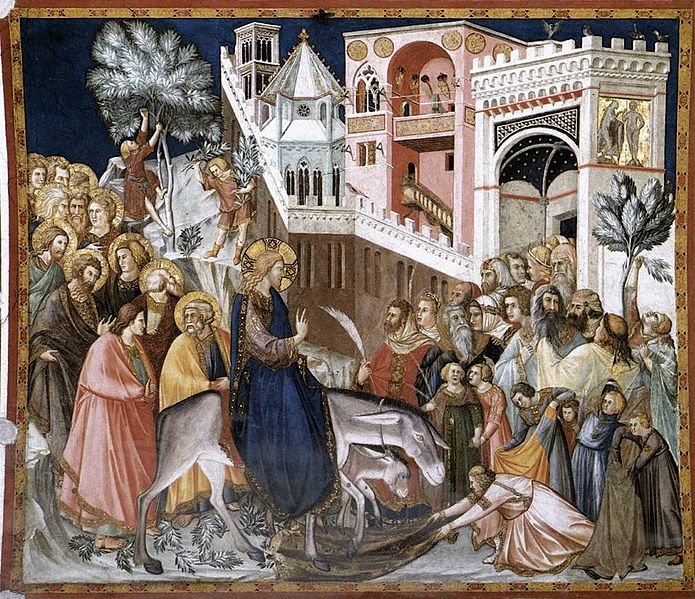Consider for a moment the following selection from the Scriptures. It contains God’s famous promise to David to establish an eternal covenant with one of David’s descendants:
The LORD spoke to Nathan and said:
“Go, tell my servant David. . . .
‘When your time comes and you rest with your ancestors,
I will raise up your heir after you, sprung from your loins,
and I will make his kingdom firm.
It is he who shall build a house for my name.
And I will make his royal throne firm forever.
I will be a father to him,
and he shall be a son to me.’” (2 Sm 7:4-5a, 12-14a)
David’s famous son was Solomon, and Solomon did, in fact, build the first temple in Jerusalem after his father death. So this passage literally seems to be referring to Solomon. But does it?
Note the promises. Along with “it is he who shall build a house for my name,” we also find these three in particular:
(1) I will make his kingdom firm.
(2) I will make his royal throne firm forever.
(3) I will be a father to him, and he shall be a son to me.
The problem with applying these promises to Solomon is that, although his kingdom was firm during his life, it split into the northern and southern kingdoms after his death, seemingly rendering the promise to “make his [David or Solomon’s] throne firm forever” empty. So too, after the kingdom was divided in this way, the northern kingdom of Israel would eventually fall to the Assyrians in 722 B.C.; the southern kingdom of Judah would similarly fall to the Babylonians in 598 B.C. Thus neither the kingdom nor the royal throne seems to have been “made firm” forever – indeed, not much longer than after the death of Solomon himself.
As for the promise that “I will be a father to him, and he shall be a son to me,” Solomon was renowned in the Scriptures for his wisdom, but also for his sins – one of the most egregious being his idolatry, the Scriptures telling us that he had taken hundreds of foreign wives, along with even more concubines, and had built hundreds of shrines to their gods in Jerusalem. Not exactly the actions of a faithful son showing obedience to his heavenly Father.

What great exegetes such as St. Jerome and St. Thomas would tell us is that there are things in the text of 2 Samuel 7 that clearly seem to “exceed the condition of the event” – the “event,” in this instance, being Solomon’s kingdom and its aftermath. These promises were only truly fulfilled, they would tell us, with the coming of Christ, when with the incarnation, death, resurrection, and ascension to the right hand of the Father, He (a) established the “kingdom of God”; (b) “made his royal throne firm forever” in heaven; and (c) as the Son of God, perfectly realized the promise that God would be “father to him, and he shall be son to me.”
The prophet who wrote 2 Samuel 7 may have had Solomon in mind, or perhaps he had no idea who he might be referring to. We don’t know. But exegetes such as St. Jerome and St. Thomas believed that the prophetic writer, whoever he was, was working as the instrument of the Holy Spirit who knew the full truth to which the words should be referred.
Solomon did build a temple, and he did reign as king. But these were all imperfect foretastes of the one in whom the promise is realized fully. Thus instead of claiming, as the fifth-century Antiochene exegete Theodore of Mopsuestia had done, that the text literally refers to Solomon and only allegorically refers to Christ – a position that was condemned at the Second Council of Constantinople in 553 A.D. – Thomas Aquinas, following Jerome, will say that the text literally, most properly, refers to Christ: its promises are only fulfilled in Him.
It’s not that they make absolutely no reference to Solomon, but they refer to him only inchoately, imperfectly, as a prefiguration of Christ. “These words should be explained,” says St. Thomas, “as being about the kingdom of Solomon insofar as it is a symbol of the Kingdom of Christ in which all the things said there will be fulfilled.”
This is worth remembering if someone tells you that the passage in Isaiah 7:14 prophesying that “a Virgin will conceive and bear a son” does not refer to Christ’s birth, or that the “suffering servant” passages in Isaiah are not really about Jesus.
He was spurned and avoided by men,
a man of suffering, knowing pain,
Like one from whom you turn your face,
spurned, and we held him in no esteem.
Yet it was our pain that he bore,
our sufferings he endured.
We thought of him as stricken,
struck down by God and afflicted,
But he was pierced for our sins,
crushed for our iniquity.
He bore the punishment that makes us whole,
by his wounds we were healed.
What is the “literal sense” of this text? This is not always as easy as people seem to think; which is why it’s good that we have saints like Jerome and Thomas to help guide us. Are these words really about Jesus and about what He did for us? Is His journey to the cross really the fulfillment of this prophecy? Did God really know centuries before the event what He would do in and through Christ?
You’d better believe it. This was a love so great He knew the moment Adam fell. The happy ending of the story was never in doubt. It’s only our part in the story that’s still to be worked out. All we have to do is follow Mary’s example and say yes.















